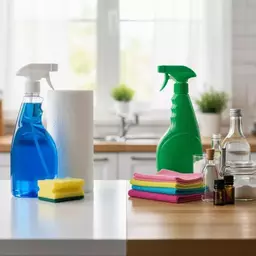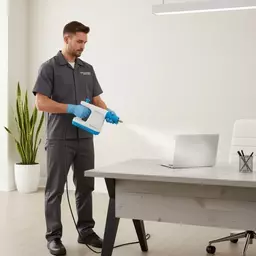Evaluating Staff Training Investments

Posted on: 2025-11-04
By: Catherine W. Devereux
In the competitive realm of commercial cleaning, understanding the economic factors at play can pave the way for smarter decisions that enhance efficiency and profitability. Consider how your cleaning strategy is affecting your bottom line—are you truly getting the value you expect?
What You Will Learn
- Evaluating both direct and hidden costs is essential when deciding between in-house and outsourced cleaning services.
- Ongoing staff training can significantly reduce liability risks and improve compliance with health regulations.
- Investing in your team’s development not only enhances productivity but also boosts employee satisfaction and retention.
- Implementing continuous improvement strategies can help you stay ahead in the evolving cleaning industry.
- Identifying and addressing gaps in training programs is crucial for long-term success and operational efficiency.
Cost Structure Comparison: In-House vs. Outsourced Cleaning
This visual outlines the direct and hidden costs associated with managing in-house cleaning teams versus outsourcing to a service provider.
In-House Cleaning: Cost Structure
Direct Costs:
- Labor (Salaries, Benefits, Overtime)
- Equipment (Purchase, Maintenance, Depreciation)
- Supplies (Ongoing chemicals & tools)
Hidden Costs:
- Liability (Training, Compliance, Insurance)
- Management Overheads (HR, Supervision)
Outsourced Cleaning: Cost Structure
Direct Costs:
- Service Contract Fee
- Specialized Cleaning Services
Reduced/Transferred Costs:
- Reduced Internal Labor Costs
- Reduced Equipment & Supply Overhead
- Transferred Liability & Compliance
- Minimized Management Overheads
Impact of Staff Training: Cost Management
Key Benefits:
- Reduced Liability (Fewer mistakes & accidents)
- Improved Compliance (Adherence to regulations)
- Enhanced Productivity (Efficiency & quality results)
- Boosted Employee Satisfaction & Retention
- Faster Job Completion (Reduced overtime)
Strategic Investment in Staff Development
Actionable Steps:
- Evaluate Current Programs & Identify Gaps
- Research Industry-Leading Training Providers
- Incorporate Employee Feedback
Training Program Types:
- Hands-on Workshops
- E-learning Modules
- Certification Programs
Understanding the Economic Landscape of Commercial Cleaning Services
In the ever-evolving world of commercial cleaning, understanding the economic landscape is crucial for making informed decisions. As facility managers and business operators, it's essential to evaluate the cost structure when considering whether to maintain in-house cleaning teams or outsource these services. Each option presents unique advantages and drawbacks that can significantly impact your bottom line! For a deeper dive into making smart business choices, consider our guide to comparing commercial cleaning services in Australia.
Let’s break down the key factors that influence your choices and explore how they can affect your operations at PristineForce.
Investigating the Cost Structure of In-House vs. Outsourced Cleaning
When weighing the cost of in-house versus outsourced cleaning, focusing on both direct and hidden costs is vital. Each staffing model has its merits, but understanding what you’re truly paying for can make all the difference. Here’s a quick overview of the direct costs:
- Labor: Salaries, benefits, and overtime pay for in-house staff.
- Equipment: Purchase, maintenance, and depreciation of cleaning equipment.
- Supplies: Ongoing expense of cleaning chemicals and tools.
While many may assume in-house cleaning is more cost-effective, hidden costs can shift the balance. It’s essential to consider these factors as well.
Direct Costs: Labor, Equipment, and Supplies
Labor costs can often be the highest expense in managing your cleaning operations. Hiring, onboarding, and training staff requires resources that may be better allocated towards specialized cleaning services. Furthermore, purchasing and maintaining high-quality equipment is essential for operational efficiency, and this is an expense that can quickly add up over time.
Remember that supplies aren’t just about cost—quality matters too! Using lower-grade cleaning products may save you money upfront but could affect cleanliness and safety standards in the long run.
Hidden Costs: Liability and Management Overheads
One of the most overlooked aspects when considering your options involves hidden costs like liability and management overheads. If you have an in-house team, you're responsible for their training, compliance with health regulations, and liability insurance. This creates additional financial pressure that often goes unnoticed. On the other hand, outsourcing can transfer some of these liabilities to the service provider, potentially reducing your risk.
Ultimately, it’s about striking a balance that fits your operational needs. Evaluating these costs carefully can yield significant savings and enhance your overall cleaning strategy.
The Role of Ongoing Staff Training in Cost Management
Now that we’ve discussed the cost structures, let’s focus on how ongoing staff training plays a crucial role in cost management. Investing in your team's development can lead to several benefits that contribute to a healthier bottom line!
- Reduced Liability: Trained staff are less likely to make costly mistakes or have accidents.
- Improved Compliance: Knowledgeable employees are better at adhering to regulations.
- Enhanced Productivity: Well-trained staff work more efficiently and deliver higher-quality results.
How Training Reduces Liability and Improves Compliance
Training your staff in safety protocols and compliance regulations can dramatically reduce liability risks. When employees understand how to handle equipment and chemicals properly, the chances of accidents drop significantly. This, in turn, protects your business from costly lawsuits and insurance claims.
Moreover, staying compliant with local regulations not only keeps your facility safe but also builds trust with your clients. At PristineForce, we believe that a well-informed team is your first line of defense against potential liabilities! Continuous training is key to maintaining these standards, and our article on essential skills for cleaning training offers valuable insights.
Boosting Employee Satisfaction and Retention Through Training
Investing in staff training doesn’t just reduce costs; it also boosts employee satisfaction and retention. When team members feel valued and see opportunities for growth, they are more likely to be engaged and committed to their roles. Happy employees tend to provide better service, ultimately leading to higher client satisfaction.
Consider this: a well-trained team is not only more efficient but also more likely to remain with your organization, reducing turnover costs and fostering a sense of camaraderie. It’s a win-win!
We Want to Hear From You!
What are your thoughts on the balance between in-house and outsourced cleaning services? Share your experiences with us:
Frequently Asked Questions (FAQs)
Summarizing the Cost-Benefit Analysis of Ongoing Staff Training
At PristineForce, we understand that ongoing staff training is more than just an expense; it’s a strategic investment that can significantly impact both financial and operational aspects of your cleaning services. In our analysis, we’ve recognized key areas where training pays off, providing a clear path toward enhanced productivity and efficiency.
To summarize, here are some vital insights we've gathered about the cost-benefit analysis of staff training in the commercial cleaning sector:
- Increased productivity leads to faster job completion and reduced overtime costs.
- Enhanced employee skills directly correlate with improved service quality and customer satisfaction.
- Regular training can minimize accidents and reduce liability costs, protecting your bottom line.
These points illustrate the profound influence that effective training programs can have on your operations. By investing in your team’s development, you pave the way for a healthier work environment, which is essential for both employee morale and client retention.
Emphasizing the Importance of Continuous Improvement
Continuous improvement isn’t just a buzzword; it’s a fundamental principle that drives success in the commercial cleaning industry. At PristineForce, we advocate for a culture that embraces ongoing learning and adaptation. The cleaning landscape is ever-evolving, with new technologies and techniques emerging regularly. Thus, keeping your team updated is crucial!
To foster a spirit of continuous improvement, consider these actionable steps:
- Implement regular training sessions that focus on emerging cleaning technologies and techniques.
- Encourage feedback from employees to identify knowledge gaps and areas for improvement.
- Create a reward system that recognizes employees who actively seek out additional training and development opportunities.
By embedding continuous improvement into your training strategy, you’re not only enhancing your cleaning standards but also strengthening your team’s commitment to excellence.
Encouraging Strategic Investment in Staff Development
Next Steps for Commercial Cleaning Companies
As we delve into the next steps, it’s crucial to recognize the importance of strategic investment in staff development. This means allocating resources towards training programs that yield measurable results. Businesses that prioritize staff training often see a ripple effect—improved employee morale, client satisfaction, and ultimately, a stronger bottom line.
Here’s how to embark on your journey toward strategic investment:
- Evaluate your current training programs and identify gaps that need to be addressed.
- Research industry-leading training providers that focus on innovative techniques and compliance standards.
- Incorporate employee feedback to tailor training programs that align with their needs and interests.
By taking these next steps, you position your company to not only withstand industry challenges but to thrive in a competitive landscape. For instance, understanding how to onboard commercial cleaning staff effectively can significantly enhance your training outcomes.
Exploring Training Programs That Drive Employee Engagement and Skill Development
Exploring the right training programs is essential for driving employee engagement and ensuring skill development. At PristineForce, we believe that training should be both informative and engaging, fostering a sense of community among your staff members.
Here are some training program types to consider:
- Hands-on workshops that allow employees to practice new cleaning techniques in real-life scenarios.
- E-learning modules that offer flexibility and convenience for busy staff members.
- Certification programs that not only enhance skills but also boost employee pride and accountability.
By selecting training programs that resonate with employees, you create an environment where learning is valued and encouraged, paving the way for a more skilled workforce.
Call to Action: Investing in Your Team for Long-Term Success
In conclusion, the case for investing in staff training is compelling. As we’ve discussed, the benefits extend far beyond immediate cost savings; they foster a culture of safety, efficiency, and quality service that can distinguish your commercial cleaning business in the marketplace. At PristineForce, we encourage all facility managers and business operators to take action now. Invest in your team, explore innovative training options, and watch your operations flourish!
Remember, a well-trained team is not just an asset; it's the key to your success in the commercial cleaning industry. Let’s commit to creating a cleaner, safer, and more productive environment together!
Recap of Key Points
Here is a quick recap of the important points discussed in the article:
- Evaluate both direct and hidden costs when deciding between in-house cleaning teams and outsourcing.
- Investing in ongoing staff training reduces liability, improves compliance, and enhances employee productivity.
- Continuous improvement through regular training and feedback fosters a culture of excellence in cleaning standards.
- Strategic investment in staff development leads to better employee morale, client satisfaction, and overall operational efficiency.
- Select engaging training programs that resonate with employees to drive skill development and enhance team dynamics.
 What if your cleaning routine could contribute to a healthier planet? By understanding the differenc
What if your cleaning routine could contribute to a healthier planet? By understanding the differenc
 In today’s fast-paced business environment, cleanliness isn’t just a luxury; it’s a necessity.
In today’s fast-paced business environment, cleanliness isn’t just a luxury; it’s a necessity.
 Effective staff training is not just an operational requirement; it’s a strategic investment that
Effective staff training is not just an operational requirement; it’s a strategic investment that
